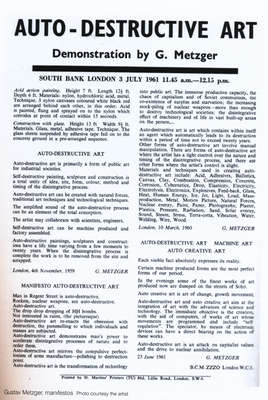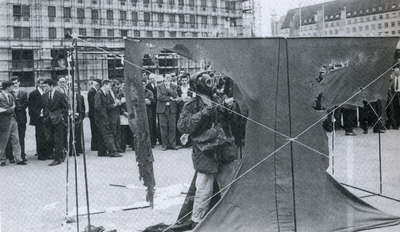Gustav Metzger was born into a Jewish-Polish family in Nürmberg and was evacuated in 1939 to England during Nazi persecution. He encountered the work of sculptor Henry Moore in 1942 while working as a furniture-maker in Leeds. With increasing interest in revolutionary politics he moved to Bristol and lived in a commune of Anarchists and Trotskyists. He followed Moore’s advice and went to art school to study life-drawing to become a sculptor.
Metzger studied at various art schools in Cambridge, London and Oxford. He travelled in Europe with a grant and exhibited paintings in group exhibitions in London whilst working as a labourer on and off until 1953. He next worked as a junk dealer and was deeply affected bt the ‘This is Tomorrow’ exhibition of British artists and architects at the Whitechapel Gallery. He showed his support by hiring a shop to show posters by the artists in the window.
In 1959 Metzger wrote a manifesto ‘Auto-destructive Art’ and connections have been drawn between this and the ideas of Bakunin regarding the dialectical relationship between creation and destruction.
From these ideas Metzger developed an ‘aesthetics of revulsion’ which he has referred to many times throughout his career. He abandoned painting in favour of using everyday objects taken from the real world – cardboard packing cases, newspapers, polythene bags of fabric scraps from garment factories.
In 1961 Metzger was jailed for civil disobedience with the Committee of 100, the anti-nuclear war group formed with the philosopher Bertrand Russell. The same year on the South Bank in London he painted hydrochloric acid onto nylon canvasses wearing a gas mask and protective clothing, so that eventually the canvas disintegrated South Bank Demonstration. The demonstration was of an artwork being simultaneously created and destroyed. Metzger also at this time conceived of a series of public art monuments, time-based sculptural projects which would be machine-made and would auto-destruct by the gradual transforming of their material over time. Typical would be a monument made of steel that would corrode over time through the action of pollution in the atmosphere.
Metzger was the initiator of the Destruction in Art Symposium in 1966, an event which marked a significant moment in the history of international exchange amongst artists associated with the counter-culture. DIAS as it was known was a forum to explore destruction in art and to relate this destruction to destruction in society. The attitude to science and technology in Metzger’s work is not undialectical. Creative potential is evidenced in Auto-creative art, (the counterpart of Auto-destructive art), the most fully realised examples being his liquid crystal light projections first shown in 1965. Chemicals, machines, the factory assembly of art and computers were aspects of technology that Metzger explored throughout the 1960s and 1970s. But the uses to which technology and science are put in capitalist society have led Metzger to a more pessimistic outlook on the potential for benign technology in recent years.
His works consciously resisted commodification by the art market, being public, performative, temporary and critical. Invited to participate in the group exhibition ‘Art into society/Society into Art’ at the ICA in London in 1974, Metzger declined due to his disillusionment with the increasing commercialisation of art. He contributed a statement to the exhibition catalogue calling for ‘Years without Art 1977-1980, a period of three years when artists will not produce work, sell work, permit work to go on exhibition and refuse collaboration with any part of the publicity machinery of the art world’. He later withdrew from both art production and the art world and embarked on years of research which included organising, with Cordula Frohwein, a conference ‘Art in Germany under National Socialism’ in London in 1976, the first to take seriously the subject of National Socialist art, architecture and design.
Interview with Gustav Metzger from 2009.




